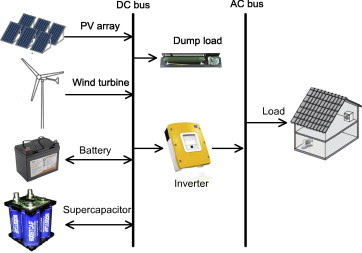The Global energy challenges and their impact on the environment have accelerated the adaptation of renewable energy sources and development of smart and efficient micro grid technologies. Low voltage micro grid in particular has attracted increasing attention from researchers. Advantage of micro grid is that it replaces inefficient long distance high voltage transmission and distribution infrastructure. Unlike grid connected micro grids having unlimited support from high inertia power generators, standalone micro grids depend on its Energy Storage System (ESS) to balance the mismatch between generated and consumed power. The ESS stores surplus energy and supply it back to the system when needed. In stand alone systems, ESS also regulate instantaneous power variations and maintaining power quality. The varying and unpredictable power supply from solar PV cells is the major cause for degradation in battery lifespan. As the battery has high energy density but not suitable for high power density, the high surge current for short duration is also unfavorable for lifetime of the battery.
In certain applications requiring large current for short duration such as motor starting, electric vehicles and digital communication systems, the batteries were over sized to meet the requirements of peak currents introduced unnecessary expenses which is hardly justified. To overcome these limitations, supercapacitors started to gain attention and are widely used for energy storage especially in the renewable energy sector. The supercapacitors were introduced into a solar PV system with battery to improve energy density. This system is known as hybrid energy storage system (HESS).
Batteries and capacitors do a similar job-storing electricity- but in completely different ways. Batteries have two electric terminals (electrodes) separated by a chemical substance called an electrolyte. Upon switching the power, chemical reactions happen involving both electrodes and electrolyte. The battery can be charged and recharged hundreds of times before it needs replacing. On the other hand capacitors use static electricity rather than chemical reactions to store energy. It consist of two conducting metal plates with an insulating material called dielectric in between them. During charging, the positive and negative charges build up on the plates and the separation between them stores the energy. Capacitors have many advantages over batteries like they weigh less, don't contain harmful chemicals or toxic metals and they can be charged and discharged zillions of times without ever wearing out. A big drawback they have is that they can not store the same amount of energy as batteries.
A super capacitor differs from an ordinary capacitor in two ways: it's plates effectively have a much bigger area and the distance between them is much smaller. The plates are made from metal coated with a porous substance such as powdery, activated charcoal, which effectively gives them a bigger area for storing much more charge. Instead of using dielectric, both plates are soaked in an electrolyte and separated by a very thin insulator. When the plates are charged up, an opposite charge forms on either side of the separator, creating what's called an electric double-layer as shown in the figure. Typical capacitors used in electronic circuits store only miniscule amount of electricity usually rated in units called micro farads, nano farads, or pico farads. On the other hand a typical supercapacitor can store a charge thousands, millions, or even billions of times bigger. The big advantage of a supercapacitor is that it can store and release energy almost instantly-much more quickly than a battery. The batteries have high energy density (store more energy per unit mass) while supercapacitors have high power density (can release energy more quickly).
 |
| Electric Double Layer in Super Capacitor (Source: www.explainthatstuff.com) |
With coupling batteries and supercapacitors together, it reduces the current stress on the batteries in order to decrease its size, improve its lifetime, decrease depth of discharge of battery and ultimately reducing the operating and maintenance cost of the system. When batteries are paired with supercapacitors, the supercapacitors can act as a buffer, relieving the battery of pulsed or high power drain. The advantages such as fast charging time, unlimited life cycle, low equivalent series resistance (ESR), robust and high power density makes it attractive and have been used to replace batteries in a number of applications. Other applications include wind turbines where very large supercapacitors help to smooth out the intermittent power supplied by the wind. In electric and hybrid vehicles, supercapacitors are increasingly being used as temporary energy stores for regenerative breaking (where the energy a vehicle would normally waste when it comes to a stop is briefly stored and then reused when it starts moving again).

No comments:
Post a Comment
Your comment will be approved within 24 hours